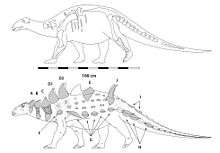Cairanoolithus
Cairanoolithus is an oogenus of dinosaur egg which is found in Southwestern Europe. The eggs are large (15–19 centimetres or 5.9–7.5 inches in diameter) and spherical. Their outer surface is either smooth, or covered with a subdued pattern of ridges interspersed with pits and grooves. Multiple fossil egg clutches are known but the nest structure is unclear.
| Cairanoolithus | |
|---|---|
 | |
| Cairanoolithus dughii | |
| Egg fossil classification | |
| Basic shell type: | †Dinosauroid-spherulitic |
| Oofamily: | †Cairanoolithidae Sellés and Galobart, 2015 |
| Oogenus: | †Cairanoolithus Vianey-Liaud et al., 1994 |
| Oospecies | |
| |
| Synonyms | |
| |
The parent of Cairanoolithus is probably some kind of non-ornithopod ornithischian, possibly the nodosaurid Struthiosaurus.
The eggs were first named in 1994, when the two oospecies were classified in distinct oogenera as Cairanoolithus dughii and Dughioolithus roussetensis. They are now considered to belong in a single oogenus, possibly even a single oospecies. Though it has been classified as a megaloolithid, Cairanoolithus is now placed in its own oofamily, Cairanoolithidae.[1][2]
Description

Cairanoolithus eggs are spherical and fairly large, measuring 15–19 cm (5.9–7.5 in) in diameter.[2][3] The outer surface is smooth or covered with a subdued netlike pattern of ridges, interspersed with pits and grooves (sagenotuberculate ornamentation).[1][2] The eggshells are made up of partially interlocking column-shaped shell units and range from 1.10 to 2.65 mm (0.043 to 0.104 in) thick.[2]
Several egg clutches of C. dughii are known, containing as many as 25 fossilized eggs.[2] Unfortunately, taphonomical alterations (changes during the fossilization process) make it difficult to determine the original structure of the nest. Cousin (2002) hypothesized that Cairanoolithus eggs were laid on the surface of the ground, possibly buried beneath a mound of plant matter.[4] Tanaka et al. (2015) noted that the shell had a high rate of water vapor conductance. Therefore, they concluded that Cairanoolithus nests were covered by organic or inorganic material, similar to modern eggs with high vapor conductance.[5]
Oospecies
Two oospecies of Cairanoolithus have been described:
- Cairanoolithus dughii is the type oospecies. At 1.57–2.41 mm (0.062–0.095 in), its eggshell is slightly thicker than that of C. roussetensis. It has slender, partially fused columnar eggshell units. Their outer surface is almost without ornamentation, and the inner surface is covered with hollows once filled by organic cores. C. dughii's eggshell exhibits an angusticanaliculate pore system, i.e. its pores are long, narrow, and straight.[1][2]
- Cairanoolithus roussetensis, which was formerly classified in its own oogenus, Dughioolithus, can be distinguished from C. dughii by its thinner eggshell (measuring 1.11–1.77 mm or 0.044–0.070 in thick), its broader eggshell units, and the relative prominence of its ornamentation.[2] Like C. dughii, C. roussetensis typically has an angusticanaliculate pore system, though some specimens have prolatocanaliculate pores, meaning they have variable diameter across their length.[1][2]
Some authors consider the two oospecies to be synonymous. Cousin (2002) argued that the differences between them were due to intraspecific variation or due to taphonomy. He also described several eggshell fragments that possibly belong to an additional distinct oospecies of Cairanoolithus;[4] however these specimens were referred to C. roussetensis by Selles and Galobart (2015).[2]
Classification
| ||||||||||||||||||||||||||||||||||||||||||||||||||||||
| Simplified version of Selles and Galobart's cladogram, showing the position of Cairanoolithus relative to other non-theropod dinosaur eggs. |
While it was formerly considered a megaloolithid, Cairanoolithus is now considered to belong its own monotypic oofamily, Cairanoolithidae. It belongs to the dinosauroid-spherulitic basic type, a group including sauropod eggs and ornithischian eggs, but paraphyletically excluding theropod eggs.[2]
The cladistic analysis done by Selles and Galobart in 2015 recovered Cairanoolithus as a sister taxon to the clade of ornithopod eggs Guegoolithus, Spheroolithus, and Ovaloolithus. Therefore, they considered it likely that Cairanoolithus belongs to a non-ornithopod ornithischian dinosaur.[2]
Parentage
Since embryos are unknown in cairanoolithid eggs, the identity of their parent is uncertain. They have long been considered to be eggs of titanosaurs or ornithopods (like Rhabdodon).[6][7] However, numerous characteristics distinguish Cairanoolithus from sauropod eggs (oofamilies Megaloolithidae and Faveoloolithidae), even though they bear superficial similarities in size and shape. Cairanoolithus's columnar eggshell units are quite unlike the fan-shaped ones seen in Megaloolithus, Faveoloolithus, or Fusioolithus. Also, its subdued ornamentation contrasts strongly with the heavily sculpted eggshells of sauropod eggs, and it has a different pore system.[2] Eggs of ornithopods (Spheroolithidae and Ovaloolithidae), on the other hand, show much closer similarity to cairanoolithids in ornamentation and pore system. However, ornithopod eggs are typically much smaller, and the crystal structure of their eggshell units is distinct.[2]

The cladistic analysis by Sellés and Galobart in 2015 supported an ornithischian parentage. Late Campanian to early Maastrichtian ornithischians from Southwestern Europe are restricted to rhabdodontids and the nodosaurid Struthiosaurus. When Sellés and Galobart analyzed the pelvises of Rhabdodon (the largest known rhabdodontid) and Struthiosaurus, they found that Rhabdodon could not have laid eggs as big as Cairanoolithus.[2] On the other hand, even though Struthiosaurus was relatively small, the unique orientation of its ischia would have easily allowed it to lay eggs as large as a 19 cm (7.5 in) cairanoolithid egg.[2] However, interpreting Cairanoolithus as the eggs of a nodosaur does raise the question of why Cairanoolithus or similar eggs have not been found in areas with a greater nodosaur abundance.[2]
Distribution
Cairanoolithus is native to Southwestern Europe, including southern France and northern Iberia. Its fossils date to the late Campanian to early Maastrichtian.[2] They are usually found in the Aix-en-Provence Basin below the Rognac Limestone.[2][3] C. dughii is from the La Cairanne site in Bouches du Rhône, France, from Roquehautes-Grand Creux and from the Villeveyrac Basin.[3] C. roussetensis is found in the northern part of Iberia (Tremp Group of Spain),[8] and from southern France (in Rousset Village, Roquehautes-Crete du Marbre, the Villeveyrac Basin, and Argelliers-Montamaud).[3][9]
Paleoecology
The Late Cretaceous ecosystems of Europe (which was then an island archipelago) show complex mixing of taxa originating from Africa, Asia, and North America.[10] In Southwestern Europe, Cairanoolithus co-occurs with numerous other types of fossil eggs; Megaloolithus is particularly common,[2][3] but theropod eggs such as Prismatoolithus[10] and the ornithopod egg Guegoolithus[11] are also present. Dinosaur body fossils are also common, including nodosaurids, rhabdodontids, titanosaurs, dromaeosaurids, basal iguanodontians, hadrosaurids, neoceratosaurians, and coelurosaurs. Other vertebrates include bony fish, squamates, cryptodiran turtles, alligatorids, and mammals.[10]
History
The Aix Basin was first excavated for fossils in 1869 by French paleontologist Philippe Matheron.[12] In the 1950s, Raymond Dughi and Francois Sirugue, a pair of French paleontologists working for the Museum d'Histoire Naturelle Aix-en-Provence, extensively studied the basin's fossil eggshells.[13] They divided the eggs they had found into ten different types, but they did not describe them in detail. In the 1970s and 1980s, further work was done by the French paleontologist[14] P. Kerourio and the German paleontologist[15] H. K. Erben.[3]
In his 1983 doctoral thesis, M. M. Penner devised one of the early classification schemes for egg fossils.[2][16] He was the first to recognize the eggs now named Cairanoolithus as a distinct type; under his classification scheme, they were called "Group 2".[2] In 1994, French paleontologists M. Vianey-Liaud, P. Mallan, O. Buscail and C. Montgelard described them under the modern parataxonomic system as Cairanoolithus dughii and "Dughioolithus" roussetensis.[3] They did not assign either of them to any oofamily, but both oogenera were classified in the oofamily Megaloolithidae by the Russian paleontologist Konstantin Mikhailov in 1996.[6] Following further discoveries in 2001, Géraldine Garcia and Monique Vianey-Liaud synomized the two oogenera.[17] In 2002, French paleontologist R. Cousin took a step further and synonymized the two oospecies.[4]
In 2012, the first Cairanoolithus fossils discovered outside of France were first reported by Albert G. Selles in his PhD thesis at Universitat de Barcelona, in which he also proposed that Cairanoolithus be moved into its own oofamily.[18] Three years later, Selles and Angel Galobart published a comprehensive reanalysis of Cairanoolithus, in which they formally named the new oofamily, Cairanoolithidae, to contain Cairanaoolithus. Contrary to Cousin's conclusions, Selles and Galobart separated the oospecies C. dughii and C. roussetensis. Also, they demonstrated that Cairanoolithus was not the eggs of an ornithopod or sauropod and conjectured that it could be the eggs of a nodosaur.[2]
References
- Carpenter, Kenneth (1999). Eggs, Nests, and Baby Dinosaurs: A Look at Dinosaur Reproduction (Life of the Past). Bloomington, Indiana: Indiana University. ISBN 978-0253334978.
- Sellés, A.G.; Galobart, À (2016). "Reassessing the endemic European Upper Cretaceous dinosaur egg Cairanoolithus". Historical Biology. 28 (5): 583–596. doi:10.1080/08912963.2014.998666.
- M. Vianey-Liaud, P. Mallan, O. Buscail and C. Montgelard. (1994) "Review of French dinosaur eggshells: morphology, structure, mineral, and organic composition." Dinosaur Eggs and Babies, Cambridge University Press, Cambridge. pp 151-183
- Cousin, R. (2002). "Organisation des postes de dinosauriens de la paralamille des Megaloolithidae Zhao, 1979 [Organization of the dinosaur nest of the parafamily Megaloolithidae Zhao 1979]". Bulletin Trimestriel de la Société Géologique de Normadie et des Amis du Muséus du Havre (in French). 89: 1–177.
- Tanaka; Zelenitsky, Darla; Therrien, François (2015). "Eggshell Porosity Provides Insight on Evolution of Nesting in Dinosaurs". PLOS ONE. 10 (11): e0142829. Bibcode:2015PLoSO..1042829T. doi:10.1371/journal.pone.0142829. PMC 4659668. PMID 26605799.
- Konstantin E. Mikhailov, Emily S. Bray & Karl E. Hirsch (1996). "Parataxonomy of fossil egg remains (Veterovata): basic principles and applications". Journal of Vertebrate Paleontology. 16 (4): 763–769. doi:10.1080/02724634.1996.10011364. JSTOR 4523773.
- Vianey-Liaud, Monique; Khosla, Ashu; Garcia, Geraldine (2003). "Relationships between European and Indian dinosaur eggs and eggshells of the oofamily Megaloolithidae". Journal of Vertebrate Paleontology. 23 (3): 575–585. doi:10.1671/0272-4634(2003)023[0575:RBEAID]2.0.CO;2.
- Sellés, A. G.; Vila, B. (2015). "Re-evaluation of the age of some dinosaur localities from the southern Pyrenees by means of megaloolithid oospecies". Journal of Iberian Geology. 41: 125–139.
- Sellés, A. G.; Bravo, A. M.; Delclòs, X.; Colombo, F.; Martí, X.; Ortega-Blanco, J.; Parellada, C.; Galobart, À. (2013). "Dinosaur eggs in the Upper Cretaceous of the Coll de Nargó area, Lleida Province, south-central Pyrenees, Spain: Oodiversity, biostratigraphy and their implications". Cretaceous Research. 40: 10–20. doi:10.1016/j.cretres.2012.05.004.
- Tabuce, Rodolphe; Tortosa, Thierry; Vianey-Liaud, Monique; Garcia, Geraldine; Lebrun, Renaud; Godefroit, Pascal; Dutour, Yves; Berton, Severine; Valentin, Xavier; Cheylan, Gilles (2013). "New eutherian mammals from the Late Cretaceous of Aix-en-Provence Basin, south-eastern France". Zoological Journal of the Linnean Society. 169 (3): 653–672. doi:10.1111/zoj.12074.
- Moreno-Azanza, M.; Canudo, J.I.; Gasca, J.M. (2014). "Spheroolithid eggshells in the Lower Cretaceous of Europe. Implications for eggshell evolution in ornithischian dinosaurs" (PDF). Cretaceous Research. 51: 75–87. doi:10.1016/j.cretres.2014.05.017.
- Matheron, P. (1869). "Notice sur les reptiles fossiles des dépôts fluvio-lacustres crétacés du bassin à lignite de Fuveau". Mémoires de l'Académie Impériale des Sciences. Belles-Lettres et Arts de Marseille (in French): 345–379.
- Taquet, Phillippe (1999). Dinosaur Impressions: Postcards from a Paleontologist [translated from French by Kevin Padian]. Cambridge, UK: Cambridge University Press. p. 199. ISBN 9780521779302.
- Kerourio, Phillippe (1981). "La distribution des "coquilles d'oeufs de dinosauriens multistratifiées" dans le Maestrichtien continental du sud de la France". Geobios (in French). 14 (4): 533–536. doi:10.1016/s0016-6995(81)80126-x.
- Wilford, John Noble (November 9, 1986). "New data extend era of dinosaurs". New York Times. Retrieved 22 May 2016.
- Carpenter, K.; Hirsch, K.F.; Horner, J.R. (1994). "Introduction". Dinosaur Eggs and Babies. Cambridge: Cambridge University Press. pp. 1–11.
- Garcia, Géraldine; Vianey-Liaud, Monique (2001). "Nouvelles données sur les coquilles d'œufs de dinosaures Megaloolithidae du Sud de la France : systématique et variabilité intraspécifique [New data on the dinosaur eggshell Megaloolithidae from southern France: systematic and intraspecific variability]". Comptes Rendus de l'Académie des Sciences, Série IIA (in French). 332 (3): 185–191. Bibcode:2001CRASE.332..185G. doi:10.1016/S1251-8050(00)91401-0.
- Selles, Albert G. (2012). Oological Record of Dinosaurs in South-Central Pyrenees (SW Europe): Parataxonomy, diversity and biostratigraphical implications (Ph.D.). Universitat de Barcelona.
